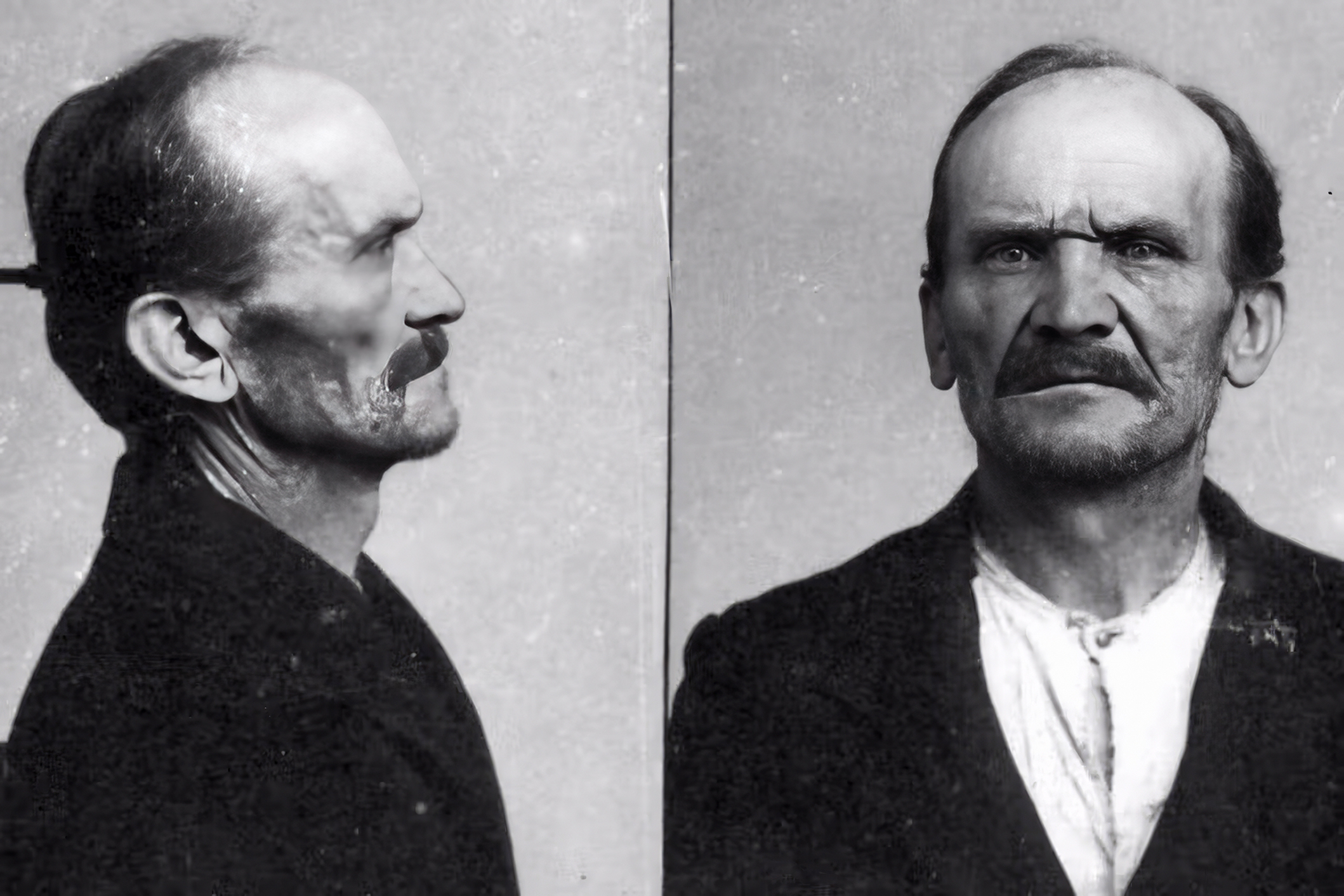Carl Grossmann
Carl Friedrich Wilhelm Großmann (born December 13, 1863 in Neuruppin ; † July 5, 1922 in Berlin ) was a serial killer who was caught red-handed and later confessed to two other murders. The estimated number of murders committed by Großmann is higher: between 23 other unsolved murders and 100 disappeared people in the Berlin area. He is considered the serial killer with probably the most victims in Germany, who was not convicted for these acts.
overview
Carl Großmann was one of eight children of the rag collector Großmann in Neuruppin . From 1876 he was an apprentice in the butchery Ferdinand Kliefoth. His bloodthirsty thoughts and statements even frightened his brother Franz. In 1879 he was dismissed for having sexually approached Kliefoth's wife.
From 1880 to 1895 he lived in Berlin, 60 km away. His first job was the butcher's Naujocks near Alexanderplatz. He later traveled through southern Germany as a beggar, peddler and petty criminal. He made himself punishable several times, u. a. for trespassing, assault and sexual offenses, and served several prison terms. He was last sentenced to 15 years in prison on October 4, 1899 in Bayreuth for crimes of morality . He had sexually abused a ten and four year old girl in one day. The four-year-old later died as a result of the crime. Released from prison, Großmann returned to Berlin in 1913, where he finally moved into a kitchen-cum-living room in Lange Straße 88/89.
Großmann often approached his victims ( prostitutes and women traveling alone) in the area around Andreasplatz and invited them to his home. In the post-war period of World War I there was high unemployment. He offered homeless women to work in his household as "housekeeper".
The area around the Schlesischer Bahnhof in the Friedrichshain district was considered one of the poorest and most wicked and had a high crime rate. In the years 1918 to 1921, body parts of women were repeatedly found in the Engel basin and in the Luisenstadt Canal , which the police were able to assign to a total of 23 victims.
On August 21, 1921, the police caught Großmann red-handed next to his last victim Marie Nitsche in his house. Neighbors heard screams and called the officers. They knocked on the door and finally broke it open. They prevented Großmann from committing suicide. Investigators found charred remains of human hands in his kitchen stove. Grossmann confessed to only three murders in the later interrogations. It is believed he could have been responsible for the disappearance of around 100 girls. That summer, the Berlin criminal police were alarmed by the body finds in the Luisenstadt Canal. In the vicinity of Großmann's apartment, between the Schilling Bridge and the Engelbecken, parts of female bodies had been found almost every day since May.
There are conjectures according to which Großmann processed his victims into sausage and canned meat, since he owned a sausage stand at the Silesian train station. It is also speculated that he ate parts of his victims himself. However, these assumptions could never be proven.
The 58-year-old Grossmann killed himself in his cell on July 5, 1922, before the main hearing, which was led by examining magistrate Walter Böhmert , among others . He had twisted a rope out of his bedding and hung himself on a nail on his cell door.
“Anyone who followed the trial against Großmann had the impression that the three accused cases were only a fraction of the lust murders of which Großmann was actually guilty. The trial ended with the suicide of the accused on the morning of July 5. "
literature
- Horst Bosetzky : The beast from the Silesian train station . Documentary novel from the 1920s. Jaron-Verlag, Berlin 2004, ISBN 3-89773-078-2 .
- Matthias Blazek : Carl Großmann and Friedrich Schumann. Two serial killers in the twenties . ibidem-Verlag, Stuttgart 2009, ISBN 978-3-8382-0027-9 .
- Peter Haining: Cannibal Killers. Murderers who kill and eat their victims . Magpie Books, London 2005, ISBN 1-84529-792-X , Chapter: “The Bread And Butter Brides” .
- Maria Tatar: lust murder. Sexual Murder in Weimar Germany . Princeton University Press, Princeton NJ et al. 1995, ISBN 0-691-04338-8 .
Web links
- Literature about Carl Großmann in the catalog of the German National Library
- The girl catcher from Berlin on welt.de, April 6, 2008
Individual evidence
- ^ Horst Bosetzky: The beast from the Silesian station. In: Berliner Kurier . March 24, 2004, accessed August 14, 2015 .
- ↑ Serial killer: The girl catcher from Berlin - News Panorama - WELT ONLINE . Welt.de. April 6, 2008. Retrieved June 13, 2010.
- ↑ erichs-kriminalarchiv . Erichs-kriminalarchiv.npage.de. August 21, 1921. Archived from the original on November 21, 2009. Info: The archive link was inserted automatically and has not yet been checked. Please check the original and archive link according to the instructions and then remove this notice. Retrieved June 13, 2010.
- ↑ s. Anne-Kathrin Kompisch: libertine - werewolf - devil. (PDF; 1.5 MB) Media images of serial killers in the German mass press 1918-1945. Diss. Univ. Hamburg 2008 and Sace Elder Murder Scenes: Normality, Deviance, and Criminal Violence in Weimar Berlin Univ. of Michigan 2010, Chap. 3 The Carl Großman Sexual Murder Case
| personal data | |
|---|---|
| SURNAME | Grossmann, Carl |
| ALTERNATIVE NAMES | Großmann, Carl Friedrich Wilhelm; Grossmann, Karl |
| BRIEF DESCRIPTION | German serial killer |
| DATE OF BIRTH | December 13, 1863 |
| PLACE OF BIRTH | Neuruppin |
| DATE OF DEATH | July 5, 1922 |
| Place of death | Berlin |
